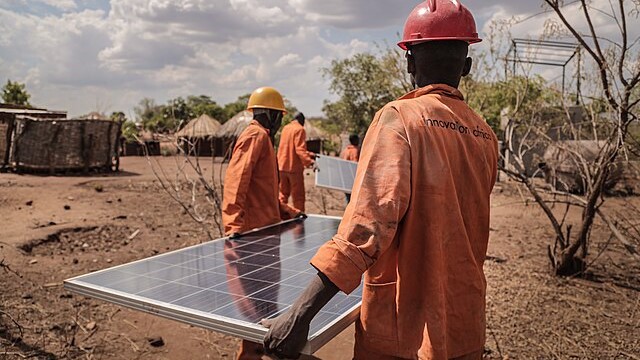By Aurélien Dombé
BANGUI, Central African Republic — On the fringes of Bangui, where nights once descended into unbroken darkness, sunlight is now captured and stored. Along the rooftops of modest cinderblock homes, solar panels gleam under the dry-season sky. Indoors, refrigerators hum, fans stir the heavy air, and schoolbooks lie open beneath steady, unblinking light.
For decades, the Central African Republic (CAR) has been defined in global headlines by political instability and humanitarian crises. Less visible is its gradual pivot toward renewable energy — particularly solar power — a shift driven as much by necessity as by environmental vision. With more than 2,800 hours of sunshine annually, the country has the raw resource to transform its energy landscape.
In a nation where fewer than 15 percent of citizens have access to electricity, and in rural areas as few as 5 percent, the appeal of solar is practical and immediate. The national grid remains fragile, hampered by outdated infrastructure, recurring fuel shortages, and the disruptions of conflict.
“Here, solar power is about more than energy,” said Marceline Ngakoutou, an energy technician with EnerCA, a Bangui-based startup. “It’s about children reading at night, medicine staying cold, and businesses keeping their doors open.”
Expanding Access
In 2022, the government, in partnership with the World Bank, launched the Emergency Electricity Supply and Access Project (EESAP). The program aims to bring off-grid solar kits to more than 200,000 people in both urban and rural areas, while training technicians to install and maintain the systems.
Vocational centers are now teaching solar installation and maintenance, with support from organizations such as Germany’s GIZ and the United Nations Development Programme. At the Technical High School of Bangui, students in blue overalls wire batteries and adjust photovoltaic cells. Among them is 19-year-old Rosine Balekouzou, who hopes to join the growing ranks of trained solar engineers. “We want to build this technology ourselves,” she said.
The International Renewable Energy Agency lists CAR as one of Sub-Saharan Africa’s most promising frontiers for solar adoption, especially in remote regions where diesel supply lines falter and roads become impassable.
Obstacles on the Horizon
The progress remains vulnerable. Political volatility and weak financial systems discourage large-scale investment. Rural areas can be difficult to reach, and customs delays often slow the arrival of critical equipment.
Even so, small-scale initiatives are multiplying. In Zémio and Birao, Electriciens sans Frontières has set up microgrids powering clinics, schools, and community radio stations. “Every panel, every battery — it’s one more step toward a different kind of future,” said Jean-Michel Doyaké, a civil engineer working in Bouar.
A Symbol of What’s Possible
In central Bangui, the solar-powered maternity ward at the Centre de Santé Saint François offers a tangible glimpse of that future. Since its inauguration, the clinic has recorded a 40 percent rise in safe nighttime deliveries. With refrigeration for vaccines and uninterrupted power for surgical lighting, staff say patient outcomes have markedly improved.
“We used to deliver babies by flashlight,” said head midwife Aimée Kombot. “Now we can see, monitor, and work with both hands.”
For a country accustomed to uncertainty, the glow spilling from a clinic doorway or the soft light of a study lamp carries weight beyond its wattage. It is a sign — small but steady — of resilience taking root.
Sources
- World Bank. Emergency Electricity Supply and Access Project: Central African Republic Project Overview. 2023.
- International Renewable Energy Agency (IRENA). Renewable Energy Prospects for Central Africa. 2023.
- Electriciens sans Frontières. Annual Impact Report. 2023.
- United Nations Development Programme. Sustainable Energy for All in Sub-Saharan Africa. 2024.


